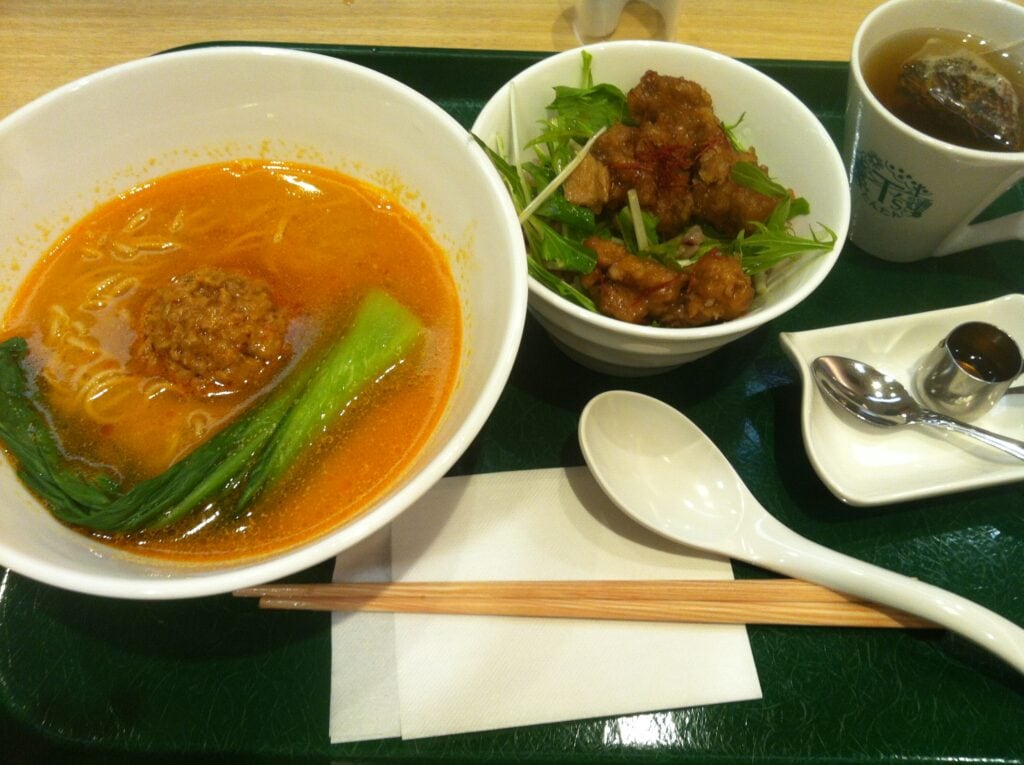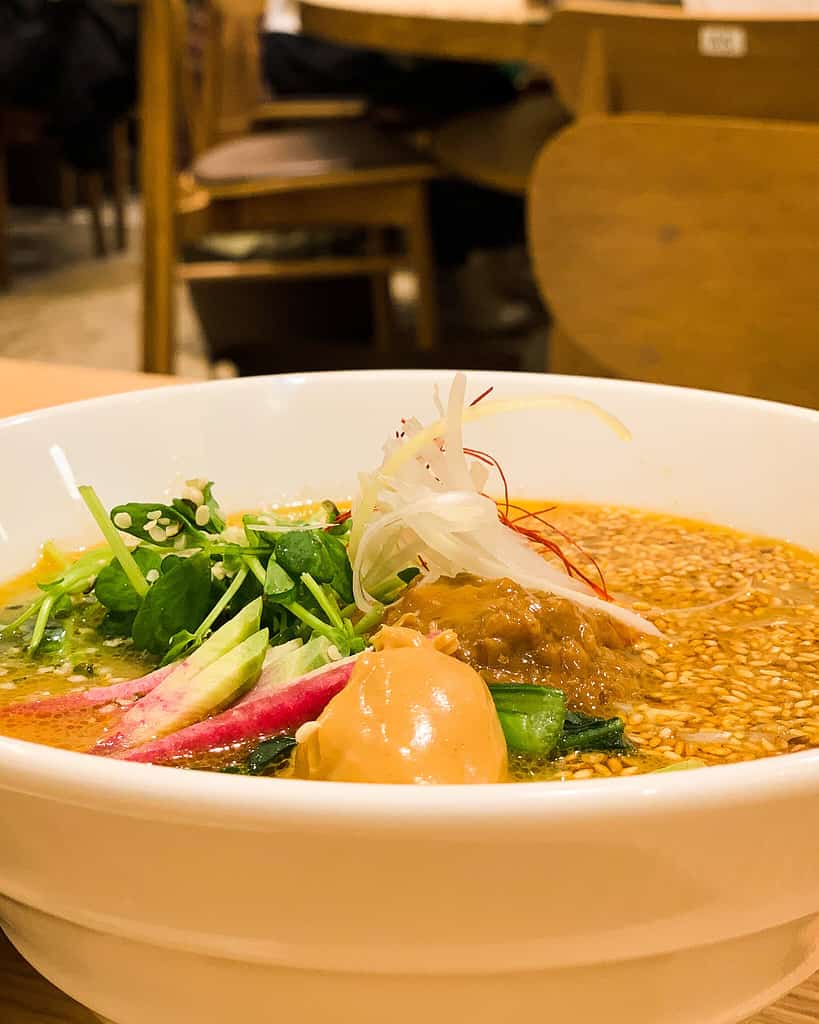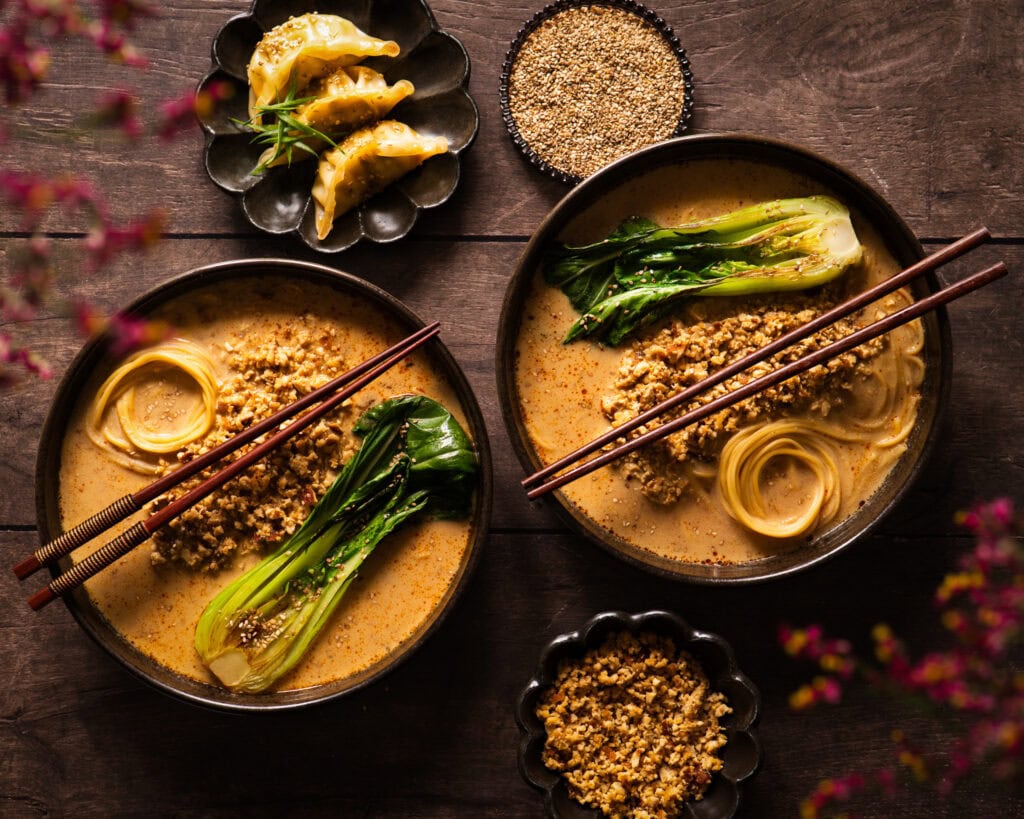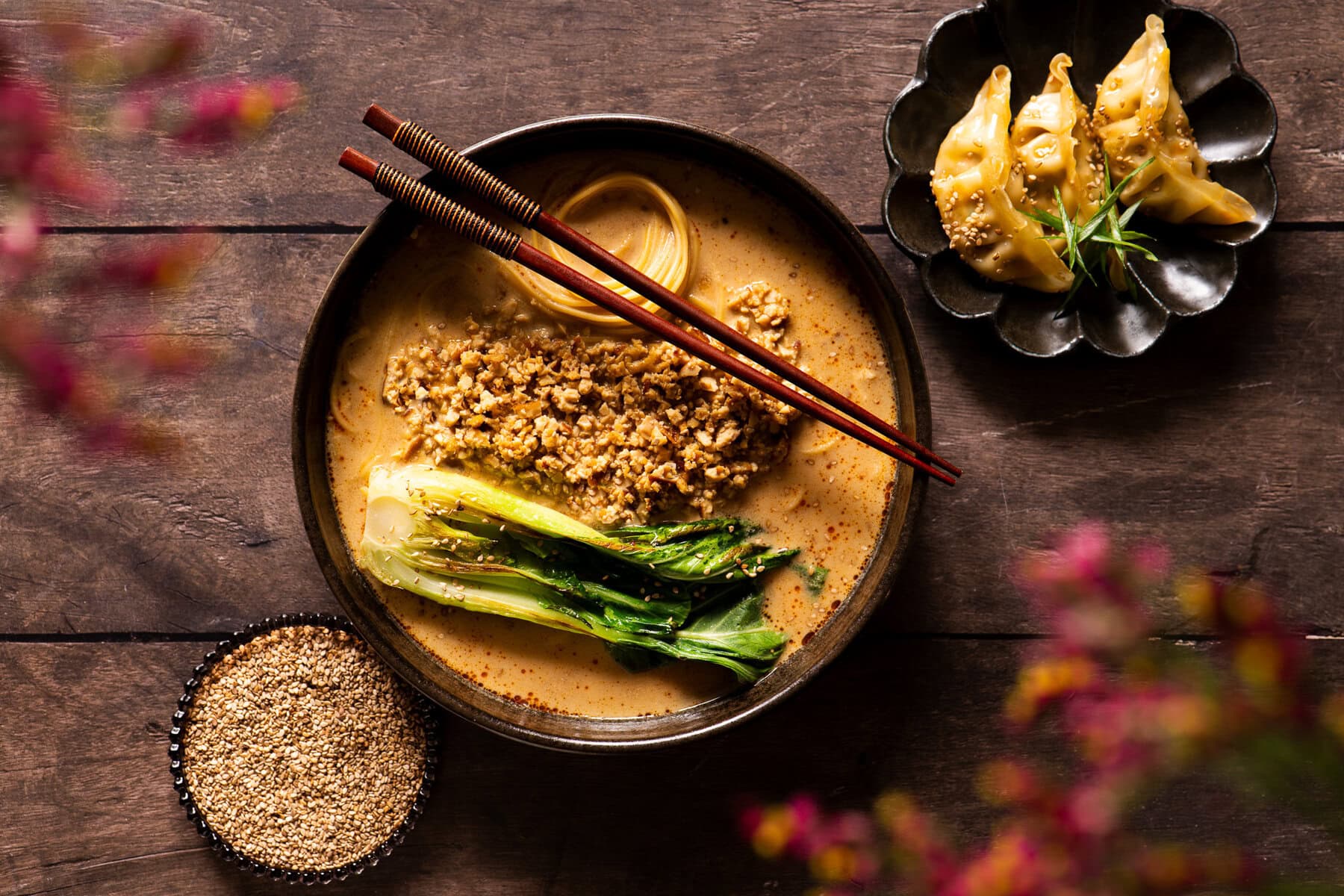The tantan soup ist one of my first and still most popular recipes and it was due for an update! I actually don’t like spring onions at all, so they’ve been unceremoniously kicked out of the recipe. Of course, you can sprinkle some on top if you like, but they haunt me all day long. More importantly, the recipe was unnecessarily complicated, and it’s now been optimized.
Where did I get the inspiration for this recipe?
At Tokyo’s main train station, there’s a vegan ramen restaurant called T’s Tantan. They serve a Japanese tantan soup that’s so good, I ride the train halfway across Tokyo, walk forever through that absurdly huge station, and even buy a train ticket for a train I don’t actually take. Just for this soup. And every single time, this delicious, slightly spicy, vegan sesame noodle soup is worth all the effort.
Is this recipe for tantan soup authentic?
It’s as authentic as I could possibly make it, trying to recreate the vegan tantan soup I’ve been eating again and again in Tokyo since I discovered the restaurant in 2012. Luckily, back then the ingredients were drawn on the wall inside the restaurant, so I had a starting point for creating a recipe that’s very similar to the one at T’s.
Since then, the restaurant has been renovated, opened several new locations, and added more soups to the menu. The Golden Sesame Tantan Soup also looks very different now, but the pretty watermelon radish they use isn’t available in Berlin—so I stuck with pak choi. I really like it anyway. Sorry for the bad 2012 photo—it doesn’t do the delicious soup justice.


I decided to use vegetable broth for this recipe, since everyone has that at home. It’s not the most authentic, but I wanted to keep the recipe as simple as possible. You can, of course, also use vegan Japanese dashi.
What do you need to make tantan soup?
- Hon Mirin is a sweet Japanese rice wine made from glutinous rice, rice malt (koji), and rice alcohol (shōchū), and fermented over several months. It has an alcohol content of about 13–14% and adds natural sweetness and depth of flavor to dishes. It’s used primarily for cooking, for example in teriyaki sauce. It’s higher quality than cheaper mirin substitutes, which often consist mainly of glucose syrup, but are often alcohol-free if you prefer that. .
- Shiro Miso is a mild miso paste that’s only aged for a short time. It contains beneficial bacteria that would be destroyed by cooking, so it’s added to the tantan soup only after it’s no longer boiling.
- Tahini is a paste made from ground sesame seeds. You could also grind sesame seeds yourself—I used to do that at first—but it’s a lot of work and doesn’t really taste any different.
- Ramen or Mie noodles are widely available nowadays. I like using spelt noodles that I buy at the organic store. Asian supermarkets also carry fresh ramen noodles in the refrigerated section, including colorful varieties made with purple sweet potatoes (a superfood from Okinawa) or other naturally colored ingredients. For the new tantan soup video and photos, I used fresh ramen noodles made with pumpkin. Rice noodles aren’t used for ramen soups.
- Smoked tofu is available in almost every supermarket now. I don’t recommend white tofu for this recipe, because it’s too soft. In a food processor, it turns into purée, not mince. That blends into the soup into a kind of mush—not what we want 🙂. If you can’t get smoked tofu, I’d recommend using soy granules instead: mix 75 g soy granules with 240 ml vegetable broth, let it sit for a few minutes, then fry with finely chopped ginger and garlic. That way you don’t need a food processor.
- Chili oil is nice and spicy and a beautiful orange. You can easily make it yourself, for example with this recipe.
- Pak choi is similar to spinach or chard and is now grown in many places, including locally. For this tantan soup, I recommend mini or baby pak choi for space reasons. In this recipe, it’s pan-fried, placed in the soup, and drizzled with chili oil.
I’ve linked these ingredients in the recipe box below so you can take a look. You can find them in Asian grocery stores, many organic stores, and well-stocked supermarkets.

Tantanmen, which is what this soup is called in Japanese, was inspired by Chinese dandan noodles, which I once tried at a vegan Szechuan restaurant in Hamburg. I almost couldn’t finish them because they were so spicy.
Japanese tantanmen isn’t quite as spicy, but of course, you can add as much chili and chili oil as you like.
Do you already have my free checklist for traveling vegans? Subscribe to my newsletter and get it now 🙂

JAPANESE TANTAN SOUP
Recommended Equipment
Ingredients
For the "meat"
- 1 tablespoon ginger, roughly chopped
- 1 smoked tofu, roughly chopped
- 1 tablespoon soy sauce
- 1 tablespoon hon mirin
- 1 teaspoon shiro miso paste*
- 1 garlic clove, minced
for the soup:
- 500 ml water
- 2 tablespoons tahini
- 2 tablespoons peanut butter
- 2 tablespoons hon mirin
- 1 tablespoon soy sauce
- 1 teaspoon veggie broth powder
- 1 teaspoon paprika powder
- 100 ml unsweetened plant-based milk
- 1 tablespoon shiro miso paste*
for the other toppings:
- 200 g ramen noodles
- 2 mini bok choy washed, outer leaves removed, cut in halves
- 1 tablespoon sesame seeds
- 1 teaspoon chili oil
Instructions
- First, prepare all the ingredients and cooking utensils. Cooking is way more relaxed this way, and you won’t forget anything 🙂 This is especially important for this recipe, because the four components are prepared at the same time, so everything needs to be ready to go.
- Put the ginger and the smoked tofu into a food processor and pulse briefly. The tofu should not be too finely ground—it should still have some texture. If you don’t have a food processor, you can also grate the smoked tofu using a coarse cheese grater, in that case you want to chop the ginger finely.
- Heat a bit of vegetable oil in a large pan, then sauté the tofu-ginger mixture over medium to high heat for about three minutes, stirring occasionally. Meanwhile, mix 1 tablespoon soy sauce, 1 tablespoon Hon Mirin, and 1 teaspoon miso in a medium sized bowl. This will be the sauce for the tofu. A small whisk works best for this.
- Add the garlic to the pan with the tofu mixture, stir well, and reduce the heat. Continue to cook over low heat, stirring occasionally.
- Bring a medium saucepan of salted water to a boil for the noodles.
- Bring a small saucepan with 500 ml of water to a boil for the soup. Add 2 tablespoons tahini, 2 tablespoons peanut butter, 2 tablespoons Hon Mirin, 1 tablespoon soy sauce, 1 teaspoon vegetable broth powder, 1 teaspoon paprika and 100 ml plant milk. When the soup starts to boil, turn the heat off.
- Cook the noodles according to package instructions in the pot of boiling water.
- Add the tofu mixture to the medium bowl with the sauce, stir to combine, and set aside. Cover the bowl with a plate to keep it warm.
- Put the pan back on the stove, add a little more oil, and raise the heat slightly. Place the pak choi in the pan, cut-side down, and brown for about 2 minutes over medium to high heat.
- Stir the miso into the soup and stir thoroughly to dissolve the miso, using a whisk works best.
- Drain the noodles and divide them between two bowls. Pour the soup over the noodles (stir well one more time before serving), then add the tofu mixture and the pak choi. Garnish with chili oil and sesame seeds, and serve with chopsticks and a spoon.
Notes
What can I use instead of bok choy?
Fresh spinach or swiss chard works well. Just add to the soup when it’s ready.
Can I use white tofu for the tantan soup?
I wouldn’t recommend. It’s too soft and turns into mash. You can use textured soy protein instead. Just mix with veggie broth and let sit for a few minutes.
You love Japan or are planning to go there? You can check out my blogpost WHERE I ATE AS A VEGAN IN TOKYO.
Do you already have my free checklist for traveling vegans? Subscribe to my newsletter and get it now 🙂



Amazing! I’ve been trying to recreate this soup since visiting Japan and this recipe is perfect! Thank you.
Oh, so happy to hear that! Thanks 🙂
Omg!! I came back from Japan last month and today I was cravinnggggg T’s Golden Tan Tan and I was searching everywhere to try find one that sounded similar and then I came across your blog and you have the exact one I’m looking for ! 😍😍 Bless you I’m so stoked, trying it out today!!
Hi Jem, thank you so much! Hope you’ll enjoy it 🙂
So similar to ts tan tan in Tokyo station – great job and thanks so much for tweaking as you go we’ve been following along. Roasting/grilling the pak choi is a great idea, worked well.
Thank you so much! Glad you like the pak choi as much as I do 🙂
Oh my god this was the best ramen I ever made! Amazing! Thank you very much for the recipe!
Thank you so much! This made my day 😊